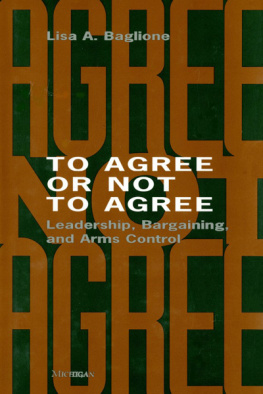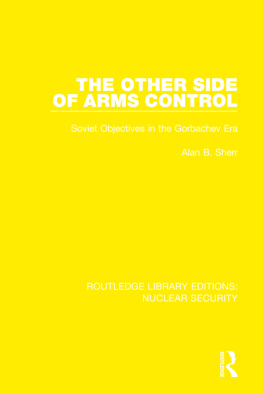Baglione - To agree or not to agree: leadership, bargaining, and arms control
Here you can read online Baglione - To agree or not to agree: leadership, bargaining, and arms control full text of the book (entire story) in english for free. Download pdf and epub, get meaning, cover and reviews about this ebook. City: Ann Arbor;United States, year: 1999, publisher: University of Michigan Press, genre: Politics. Description of the work, (preface) as well as reviews are available. Best literature library LitArk.com created for fans of good reading and offers a wide selection of genres:
Romance novel
Science fiction
Adventure
Detective
Science
History
Home and family
Prose
Art
Politics
Computer
Non-fiction
Religion
Business
Children
Humor
Choose a favorite category and find really read worthwhile books. Enjoy immersion in the world of imagination, feel the emotions of the characters or learn something new for yourself, make an fascinating discovery.
To agree or not to agree: leadership, bargaining, and arms control: summary, description and annotation
We offer to read an annotation, description, summary or preface (depends on what the author of the book "To agree or not to agree: leadership, bargaining, and arms control" wrote himself). If you haven't found the necessary information about the book — write in the comments, we will try to find it.
Baglione: author's other books
Who wrote To agree or not to agree: leadership, bargaining, and arms control? Find out the surname, the name of the author of the book and a list of all author's works by series.
To agree or not to agree: leadership, bargaining, and arms control — read online for free the complete book (whole text) full work
Below is the text of the book, divided by pages. System saving the place of the last page read, allows you to conveniently read the book "To agree or not to agree: leadership, bargaining, and arms control" online for free, without having to search again every time where you left off. Put a bookmark, and you can go to the page where you finished reading at any time.
Font size:
Interval:
Bookmark:

Copyright by the University of Michigan 1999
All rights reserved
Published in the United States of America by
The University of Michigan Press
Manufactured in the United States of America Printed on acid-free paper
Printed on acid-free paper
2002 2001 2000 1999 4 3 2 1
No part of this publication may be reproduced, stored in a retrieval system, or transmitted in any form or by any means, electronic, mechanical, or otherwise, without the written permission of the publisher.
A CIP catalog record for this book is available from the British Library.
Library of Congress Cataloging-in-Publication Data
Baglione, Lisa A., 1962
To agree or not to agree : leadership, bargaining, and arms
control / Lisa A. Baglione.
p. cm.
Includes bibliographical references and index.
ISBN 0472-109308 (cloth : acid-free paper)
1. Nuclear arms control. 2. United StatesForeign
relations19451989. 3. World politics1945- I. Title.
JZ5665 .B37 1998
327.17470973dc21 9825388
CIP
ISBN13 9780-47210930-2 (cloth)
ISBN13 9780-47202720-0 (electronic)
To my mother,
for her unfailing support,
and
in memory of my father,
who encouraged me to follow
my hearts desires
It [leadership] is among the most challenging of human activities, stirring ambition, exciting admiration, arousing fear or pity (to ones taste), inspiring the dramatists since literature began, ignored by almost nobody in all of human historyuntil the coming of American political science.
Richard Neustadt
After the collapse of the USSR, some scholars believed that traditional security issues, like arms control, would fade in importance in the post-Cold War era. Recently, however, observers have come to recognize that this optimism was premature. In fact, the leakage of nuclear materials from the territory of the former Soviet Union, the Russian governments decision to sell reactors to Iran, its failure to ratify the START II treaty, and the Western decision to expand NATO suggest that Russian and American nuclear policies and their security relationship will continue to be of concern to students of international relations.
Despite more than 50 years of American-Soviet arms bargaining, however, we still do not fully comprehend why military rivals with fundamental differences in interests, domestic institutions, and values pursued negotiations to limit a principal source of their security and prestige. This book advances a framework for understanding that endeavor: the leadership model, developed from bargaining theory, constructivism, cooperation theory, and studies in comparative politics on the sources of power in the United States and the Soviet Union. From bargaining theory comes the insight that the key factors in determining strategy are the alternatives that a party has to arms control and the value that it places on a particular accord. a partners concerns without expecting an adjustment in return, refuse to compromise, participate in negotiations only as part of a public relations campaign, or eschew talks altogether. Clearly, policy choice was a complex decision, and preferences were often contingent upon the expected effects on the opponent.
International concerns, however, were just one set of issues facing officials as they chose negotiating strategies. As specialists on interstate cooperation assert, bargaining is a two-level game, and elites had to consider international and domestic factors simultaneously when charting the national course. was accountable and the date for choosing the leader was in the distance, he had the freedom to pursue the policy options that he favored. Conversely, when support was low and an election or selection was fast approaching, the executive tended to tailor his program to address the preferences of other powerful actors in the system. Thus, these factorssupport and timinginteracted to determine a leaders autonomy, his ability to define policy independently in his system.
An executives level of autonomy and preferred strategy together affected the national approach to arms control. When autonomy was low, leaders tended to doubt their ability to overcome the ideological and structural impediments to following anything other than a positional strategy at the table, regardless of their own preferences. Under those conditions, the chief governmental official engaged in transactional leadership, trying to please constituents and other powerful actors in the system in exchange for their support. A strong executive, however, could choose an approach depending on his assessment of the alternatives his state faced and the value of an arms control agreement. With traditional perceptions of the insignificant value of an arms control agreement, a leader would typically implement a strategy that would enhance the states position relative to the opponent, regardless of his assessment of alternatives. Conversely, a highly autonomous executive who perceived an accord as valuable could elect to pursue an approach that he believed was beneficial for his state, regardless of its impact on the relative balance of power. Such leaders followed
To test the validity of the leadership model against existing approaches, this book examines several cases of Soviet and American arms control decision making: (1) the test ban negotiations of 195860 that ended in failure, (2) the resumption of talks that produced the Limited Test Ban Treaty, (3) the breakdown of discussions on Intermediate-range Nuclear Forces (INF) from 198183, (4) the resurrection of negotiations and successful conclusion of an INF agreement from 198487, and (5) the steps taken as the USSR collapsed, including the completion of the START I agreement and the unilateral American and Soviet decisions to reduce strategic readiness and nuclear stockpiles.
I chose the test ban and INF cases because those sets of negotiations allowed me to examine opposite outcomes of the bargaining process while keeping the historical context as similar as possible. During the periods 195863 and 198087, the Americans and Soviets were engaged in negotiations to institute a test ban and to reduce intermediate-range nuclear forces, respectively. Each set of discussions, then, provides for the analysis of an arms control failure (1960 and 1983) as well as a success (1963 and 1987). In addition to maintaining similarities in the cases across the test ban and INF issues, these two historical periods provide interesting comparisons. During both the test ban and the INF talks, many participants in the discussions felt that the United States and USSR were contesting for predominance in the international system. Moreover, throughout these periods, there was also diversity in the nature of the leaderships and their corresponding ideological or bureaucratic bases. These cases, then, provide challenging tests of the leadership model versus the alternative approaches and give the investigator insight into the impact of international-and domestic-level variables on interstate bargaining behavior and outcomes.
In addition, while the last pair, the minicases of 1991, are both examples of arms control success, they permit me to examine bargaining behavior in a period in which the international system was undergoing enormous upheaval (bipolarity was disintegrating) and the Soviet state was experiencing national and political revolutions. These cases also help me explore further the influence of the competing variables compared to that of autonomy and preferred strategy. Moreover, including these instances of arms bargaining allows for the examination of a greater variety of strategies; in 1991, the United States and the USSR both made decisions to reduce their arsenals unilaterally.
Font size:
Interval:
Bookmark:
Similar books «To agree or not to agree: leadership, bargaining, and arms control»
Look at similar books to To agree or not to agree: leadership, bargaining, and arms control. We have selected literature similar in name and meaning in the hope of providing readers with more options to find new, interesting, not yet read works.
Discussion, reviews of the book To agree or not to agree: leadership, bargaining, and arms control and just readers' own opinions. Leave your comments, write what you think about the work, its meaning or the main characters. Specify what exactly you liked and what you didn't like, and why you think so.












